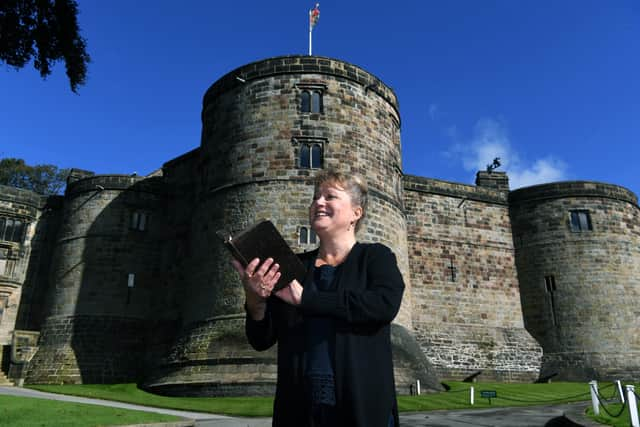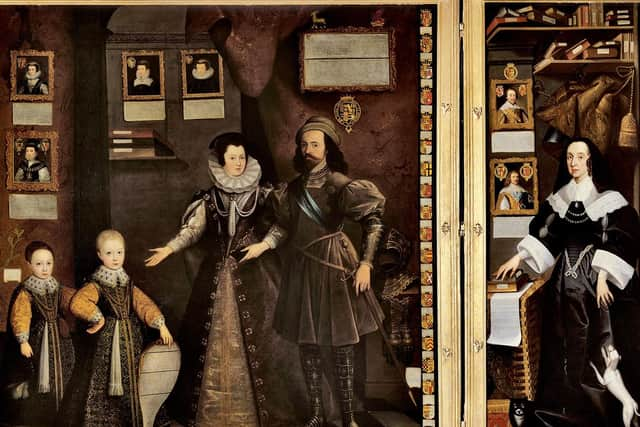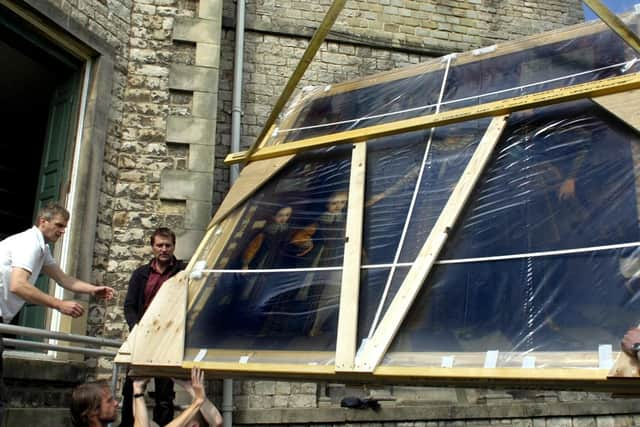Lady Anne Clifford’s ‘lost library’ uncovered by Yorkshire biographer
As a young girl, Lady Anne Clifford was said to have been “much beloved” by Queen Elizabeth I – and like the monarch who admired her, the Yorkshire noblewoman went on to prove herself a woman of great strength and determination whose life and achievements are remembered and studied to this day.
Born in 1590 at Skipton Castle, she was the only surviving child of George Clifford, 3rd Earl of Cumberland, but when he died in 1605 he willed his estates to his younger brother rather than her. After a legal battle lasting four decades to inherit her father’s estates instead of taking the £15,000 that was left to her, she finally succeeded and devoted herself to restoring and enhancing the castles and churches on her lands in Yorkshire and Cumbria before her death at the age of 86.
Advertisement
Hide AdAdvertisement
Hide AdNow Professor Jessica Malay, from the University of Huddersfield and a leading authority on Lady Anne, has made an inadvertent and important discovery about her book collection that is causing excitement in historical circles.


Malay has uncovered a previously-overlooked inventory of books belonging to Lady Anne which has almost doubled the number she is known to have owned.
Lady Anne was known throughout England as not just a scholar with a quick legal mind, but also as a prolific writer and diarist. However, until Malay’s recent discovery the evidence for her personal book collection was limited.
Malay has been commissioned to write an article about the find in the esteemed Papers of the Bibliographical Society of America, while the research will help with a biography of Clifford she hopes will be ready for publication in 2022.
Advertisement
Hide AdAdvertisement
Hide AdMalay was conducting research last winter at the Bodleian Library in Oxford as a Sassoon Visiting Fellow that was focused on Clifford’s correspondence with antiquarian Roger Dodsworth.


But while doing this, she came across a manuscript commissioned by Lady Anne’s grandson and heir Thomas Tufton in 1684 and realised that it included a list of books belonging to Anne Clifford at Appleby Castle.
The inventory of 109 books contains some that were already known to belong to her but also an additional 79 that were not previously connected to her.
Malay says the link between Lady Anne and her reading habits has always been clear to historians, especially as a giant portrait of her that she commissioned called The Great Picture shows her with dozens of books - but there has been a previous lack of evidence about the full extent of her collection.
Advertisement
Hide AdAdvertisement
Hide Ad“The picture clearly showed she read widely and we always knew she had a wider reading interest than what was in the picture but we had no evidence for anything,” she explains. “This discovery almost doubles what we know about what she was reading.”


Books unique to this new list include William Harvey’s The Anatomical Exercises of Dr. William Harvey (1653) describing the principle of blood circulation. There is an edition of Serlio’s First Booke of Architecture (1611) – Lady Anne was a keen builder, rebuilding five castles – and two books by Francis Bacon, Sylva Sylvarum: or A naturall historie (1627) and The historie of the raigne of King Henry the seventh (1611).
“The majority of the books in this new inventory are theological, focusing on how to live a good Christian life,” Malay explains. “And there are also a fair number of history books about the Tudors and Stuarts. Lady Anne was a keen historian, and much of this history she also witnessed first-hand. The scientific books and books on travel and geography that appear only in this inventory also expand our understanding of her interests.”
Malay says that at the time, building an extensive library was something of a fashion - but whereas some of the upper classes did it for show, she believes Lady Anne had a genuine interest in the writings she purchased.
Advertisement
Hide AdAdvertisement
Hide Ad“For someone like Anne Clifford, acquiring books wasn’t that difficult because you could buy books without binding,” she says.
“Book buying was quite robust at this point but it was expensive to get bound folio copies. It would be the equivalent of half-a-year’s wages for one of her servants for just one folio book.
“She celebrated communion four times a year and would buy 20 to 30 books to give out to her servants. Some of them kept them and they show up in their wills.
“There was a social cachet to having a good library. There were gentlemen who had libraries of over 1,000 books where it is clear they had been bought to show them off as a well-read person. It was part and parcel of showing she was an aristocratic person who was well educated and had authority. She is often portrayed as someone fighting in a man’s world but she learnt from sleeping in a chamber with her aunt outside Queen Elizabeth’s chamber that woman could hold and execute authority and she wanted to do it.”
Advertisement
Hide AdAdvertisement
Hide AdMalay began The Anne Clifford Project at the University of Huddersfield in 2010 and went on to publish Anne Clifford’s Great Books of Record in 2015 and Anne Clifford’s Autobiographical Writing in 2018.
She says the noblewoman was a deeply fascinating person whose life – in which she outlived three monarchs and the Lord Protector Oliver Cromwell – has relevance to this day.
“It is a combination of her vulnerability but also her absolute steadfastness to get her northern lands. I think that was related to her mother’s influence, who was keen she understood she was the descendant of remarkable men and especially remarkable women and that it was her right to these lands.”
Lady Anne had married Richard Sackville, 3rd Earl of Dorset, in 1609, who is described by English Heritage as a “notorious wastrel and spendthrift”.
Advertisement
Hide AdAdvertisement
Hide AdAgainst the wishes of her husband and also King James, Lady Anne continued to pursue her claim to the northern lands with her mother as her only ally. After Sackville’s death in 1624, she married Philip Herbert, 4th Earl of Pembroke, but the couple were soon estranged and during the English Civil War Lady Anne remained loyal to the King while Pembroke sided with the Parliamentarians.
When she finally managed to regain her family estates in 1643, the Civil War meant that it was only six years later when she was well into her 50s that she felt safe to leave London and return North.
The five castles she inherited – Skipton in Yorkshire and Brough, Brougham, Appleby and Pendragon in Westmorland – were in varying states of ruin but she set about repairing and restoring them. She would regularly travel between them all during the final 27 years of her life.
Malay says: “At that time, people did go to great lengths to secure their land rights. But when her husband was running away with mistresses and the king is angry with her and the Archbishop of Canterbury is telling her she is crazy, she sticks at it.
Advertisement
Hide AdAdvertisement
Hide Ad“When she does inherit in her 50s, she jumps into it. She had a great life in London and yet she goes up to Westmorland in Cumbria.”
But as well as her practical and legal mindset, Lady Anne was also a woman of literature and was described by the poet John Donne as being able to “discourse of all things from Predestination to Slea-silk”.
Following her recent discovery, Malay says while plenty of Clifford’s own writing has been preserved, she believes there is likely to more out there – in particular her daily diaries.
“It is a great dream of every literary historian to discover things about their subject. My great dream is to find a few more of her day books. If we could get that, it would be bigger than Samuel Pepys. We currently only have the last three months of her life. It is everything that happens to her on every day – who visits her, what she remembers, when she gets her hair cut – even her bowel movements.
Advertisement
Hide AdAdvertisement
Hide Ad“There is no evidence they have been destroyed. A lot of her manuscripts survived through her family. Things were given away and books do pop up fairly regularly that were hers.”
Malay says Clifford’s story is often presented as that of a woman in a man’s world but the truth is more complex. “Women had a lot of agency and yes they had to struggle a lot of times through the inequities of the age. But they were incredibly resourceful at working with the system and overcoming the system. That is not just Lady Anne Clifford.
“Women still have those barriers to overcome but women have always had the resources to find a way through the difficulties they have.”
Huge respect for Clifford
Deep respect for Lady Anne Clifford continues to this day, says Professor Malay.
Advertisement
Hide AdAdvertisement
Hide Ad“In Cumbria, you still have to call her the Lady Anne. It is almost like she was around the other day.”
According to English Heritage, similar regard was often shown towards her in her own lifetime.
A spokesman for English Heritage says: “Anne was a staunch Royalist, but when it was suggested to Oliver Cromwell that he should stop her building, he is said to have replied: ‘Let her build what she will, she shall not be hindered by me.’ Since she had no soldiers, her castles would have been useless as fortresses. No doubt Cromwell realised this, and appreciated that what she was really doing was converting castles into country mansions.”
Support The Yorkshire Post and become a subscriber today.
Your subscription will help us to continue to bring quality news to the people of Yorkshire. In return, you’ll see fewer ads on site, get free access to our app and receive exclusive members-only offers.
Advertisement
Hide AdAdvertisement
Hide AdSo, please - if you can - pay for our work. Just £5 per month is the starting point. If you think that which we are trying to achieve is worth more, you can pay us what you think we are worth. By doing so, you will be investing in something that is becoming increasingly rare. Independent journalism that cares less about right and left and more about right and wrong. Journalism you can trust.
Thank you
James Mitchinson
Comment Guidelines
National World encourages reader discussion on our stories. User feedback, insights and back-and-forth exchanges add a rich layer of context to reporting. Please review our Community Guidelines before commenting.